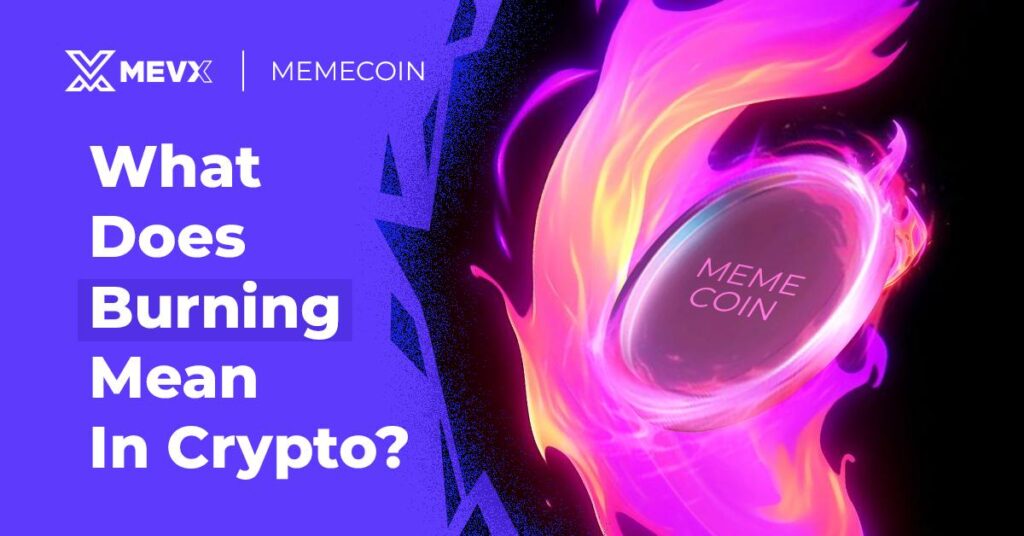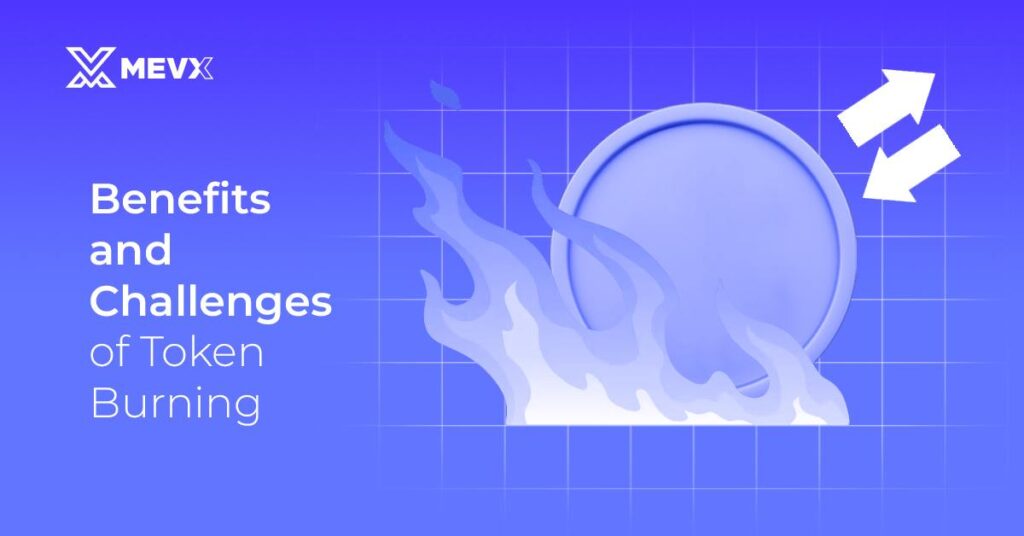Burning in crypto refers to sending tokens to an inaccessible address, effectively removing them from circulation. This process helps reduce token supply and can influence a project’s economic model. Let’s explore “What does Burning Mean in Crypto?” and its effects on the market.

What Does Burning Mean in Crypto?
Burning tokens send them to a wallet address, often called a “burn address” or “eater address.” In such an address, nobody has private keys to get the tokens, which are lost forever.
Purposes of Burning Tokens
Burning tokens in crypto serves several important purposes. At its core, “What does Burning Mean in Crypto?” refers to reducing the total supply by sending tokens to an inaccessible address.
This can increase the value of the remaining tokens, following the basic principle of supply and demand. It also acts as a deflationary mechanism, where burning combats inflation by limiting the total supply over time.
Additionally, burning can engage the community, with some projects allowing users to vote on burns, creating a sense of involvement. Lastly, burning transaction fees or tokens can align economic incentives, ensuring that as the platform grows, the token’s value rises due to decreased supply.
How Does Token Burning Work?
Token burning is a process in which cryptocurrencies are systematically and irrevocably withdrawn from circulation. Now, let’s get into the details of how and what happens during burning:
Manual Burns
Manual burns are done at the discretion of the team or community behind the project. Here’s how it works:
- Controlled Execution: The team chooses when to burn and how many tokens to burn. This may be based on the completion of milestones, market conditions, or community voting.
- Transparency: Projects build trust by publishing the proof of burn. For example, the blockchain explorers show the record of transactions moving tokens to an unspendable “burn address.”
- Example of Use: During promotional events, tokens are often burned manually to adjust the supply if the market dynamics suddenly change.
Algorithmic Burns
In algorithmic burning, automation occurs based on predefined criteria encoded into smart contracts.
- Smart Contract Integration: Tokens are burned according to triggers, such as transaction volume, fees collected, or specific network activities.
- Continuous Supply Adjustment: This method ensures consistent burning and maintains a predictable economic model.
- Example of Use: Algorithmic burning has been used in many Decentralized finance (DeFi) protocols for managing fees or attempting to stabilize the value of a token.
The Burn Address: A Black Hole
A burn address is a public wallet that nobody controls. Tokens sent here cannot be accessed, effectively removing them from the system forever.
- Key Features: There are no private keys for the address. All transactions are transparently viewable on the blockchain.
- Symbolism: This is a sign of a project’s commitment to supply reduction and, subsequently, increased token value over time.
What does burning mean in crypto? Key Examples
The following are key examples of token burning:
1. Binance Coin (BNB): Quarterly Burns
Binance Coin (BNB) has a structured approach to token burning, which occurs quarterly. The goal is to reduce BNB’s total supply from 200 million to 100 million tokens. To achieve this, Binance uses a portion of its profits to repurchase and burn BNB tokens, lowering the supply over time.
The burning mechanism creates a deflationary effect, as reducing the supply can lead to increased scarcity and, potentially, a rise in value for the remaining tokens. Additionally, these regular burns help boost market confidence, showing that Binance is committed to the long-term health of the BNB ecosystem.
Binance ensures transparency in this process by performing proof of burn on blockchain explorers, allowing the community to track each burn and reinforcing trust in the exchange’s commitment.
2. Ethereum (ETH): EIP-1559 and Fee Burning
Ethereum introduced a significant burning mechanism with the implementation of EIP-1559 during its London Hard Fork in 2021. This change altered the way transaction fees work on the network. Now, a portion of each transaction’s base fee is automatically burned as part of the transaction process.
The primary goal of this burn is to create a deflationary effect by reducing the overall supply of ETH over time. As network activity increases, more ETH is burned, which can enhance scarcity and potentially increase the value of the remaining tokens. This mechanism also encourages users to hold onto their ETH, reinforcing scarcity.
The impact of EIP-1559 has been notable: Ethereum became somewhat deflationary, particularly during periods of high network usage. This shift has bolstered trust in Ethereum’s long-term value and its position as a leading blockchain in the crypto ecosystem.
3. Shiba Inu (SHIB): Community-Driven Burns
Shiba Inu (SHIB) has gained attention for its community-driven token burn initiatives. Unlike other projects, SHIB holders actively participate in the burning process by voluntarily sending tokens to a burn address. This decentralized approach allows the community to take part in the project’s economic mechanics.
The main purpose of these burns is to reduce the massive supply of SHIB tokens, which could help increase the value of each remaining token over time. Additionally, the burn initiatives serve to build trust and engagement within the Shiba Inu community, creating a sense of shared purpose and involvement.
Shiba Inu has also seen creative ways to tie burning to activities such as gaming, purchases, and even charitable donations. These efforts not only help reduce supply but also encourage broader community participation, further strengthening the ecosystem.
What does burning mean in crypto? Benefits and Challenges
Let’s explore the benefits and challenges of burning tokens:

Benefits of burning crypto
Token burning brings several benefits: it enhances scarcity, potentially increasing token value by reducing supply. Transparent and regular burns build community confidence, signaling developer commitment. Burning fees or rewards also align incentives, linking the token’s value to its utility within the ecosystem.
Challenges of burning crypto
Token burning comes with several challenges. Without transparency, it can be seen as manipulative, especially if price fluctuations follow burns. Large burns can also trigger price volatility, leading to unpredictable market movements.
Regulatory concerns may arise as laws evolve, questioning the legality of burns and their potential for market manipulation. Additionally, over-reliance on burns could detract from more critical development goals, such as technological upgrades or ecosystem growth.
What does burning mean in crypto? – Future Trends
In the future, token burning in crypto could evolve into more sophisticated mechanisms, potentially integrating with advanced DeFi systems or real-world data, such as linking burns to carbon credits in eco-friendly projects.
As tokenomics becomes more complex, burning may play a pivotal role in reward structures, penalties, and ensuring the long-term sustainability of crypto ecosystems.
This evolution could further enhance the strategic use of burns in shaping the economic landscape of cryptocurrency.
Is Token Burning Always Effective?
While the token burn has obvious economic and psychological benefits, it is by no means a guarantee to raise value. The token would still be heavily influenced by market sentiment, the utility of the project itself, and wider crypto trends.
In conclusion, understanding “What does burning mean in crypto?” is key to navigating the market with confidence. Token burning is a powerful strategy that creates scarcity, fosters trust, and incentivizes participation. However, it should be seen as part of a broader, well-rounded strategy for long-term success in the crypto ecosystem.
Follow our blog for more tips, and advice from experts, and stay ahead in the crypto landscape!
Share on Social Media:
